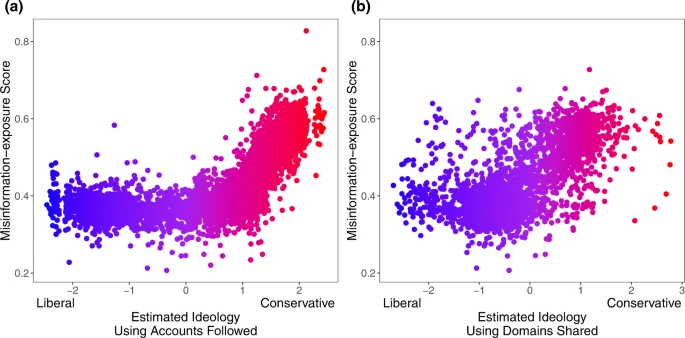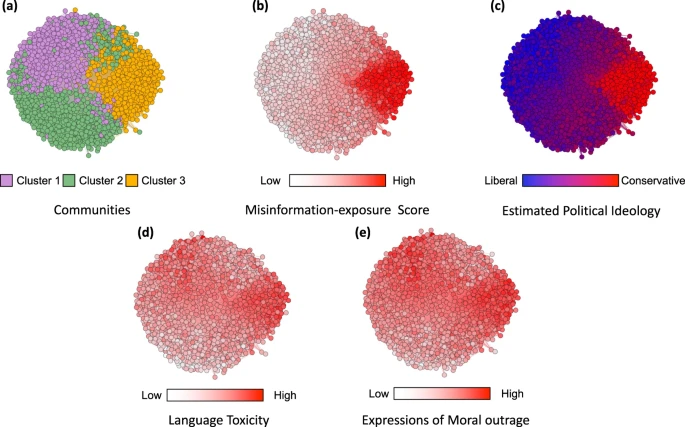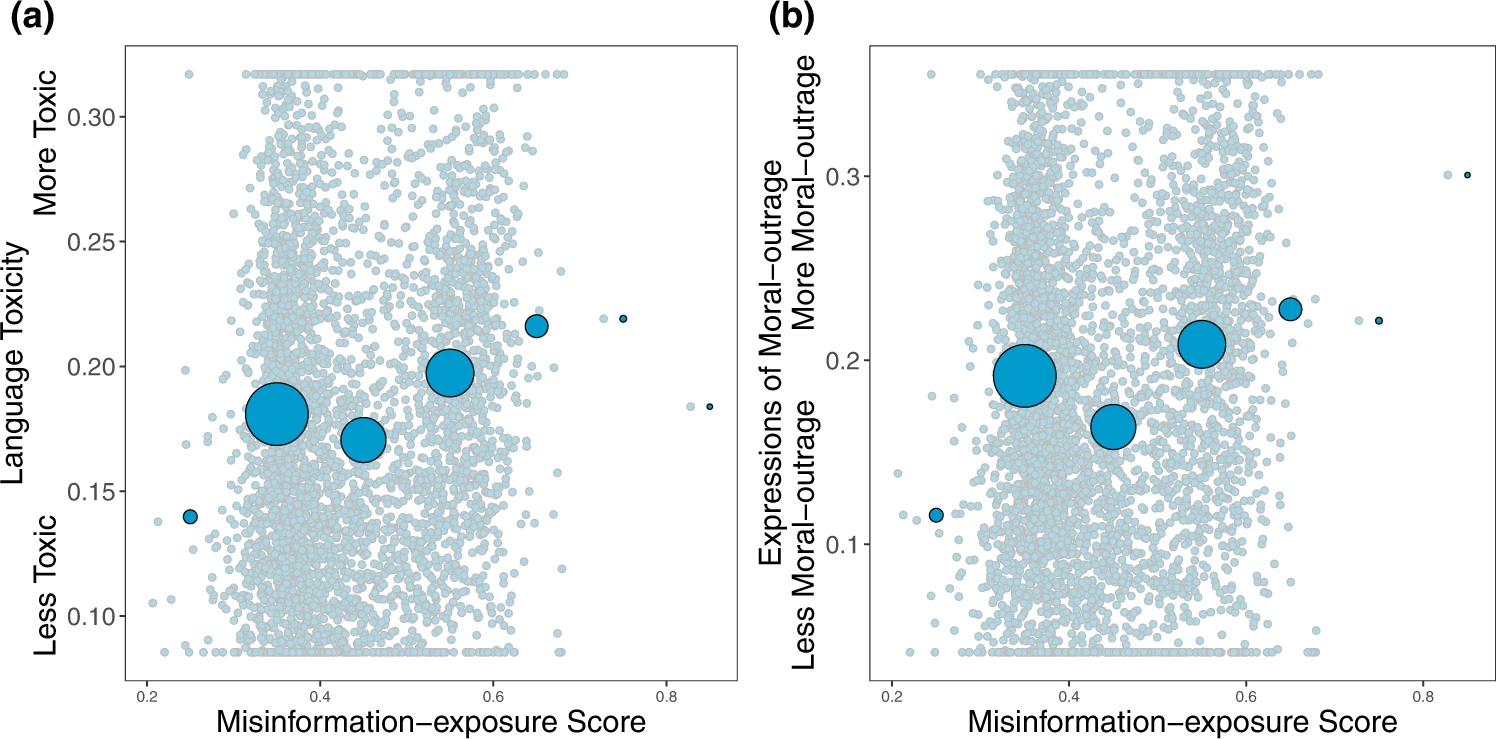buy some guns, and kill a million people.<br /> there, a million problems less : )
- Nov 2023
-
www.youtube.com www.youtube.com
-
- Dec 2022
-
link.springer.com link.springer.com
-
We analyzed URLs cited in Twitter messages before and after the temporary interruption of the vaccine development on September 9, 2020 to investigate the presence of low credibility and malicious information. We show that the halt of the AstraZeneca clinical trials prompted tweets that cast doubt, fear and vaccine opposition. We discovered a strong presence of URLs from low credibility or malicious websites, as classified by independent fact-checking organizations or identified by web hosting infrastructure features. Moreover, we identified what appears to be coordinated operations to artificially promote some of these URLs hosted on malicious websites.
-
-
www.sciencedirect.com www.sciencedirect.com
-
Drawing from negativity bias theory, CFM, ICM, and arousal theory, this study characterizes the emotional responses of social media users and verifies how emotional factors affect the number of reposts of social media content after two natural disasters (predictable and unpredictable disasters). In addition, results from defining the influential users as those with many followers and high activity users and then characterizing how they affect the number of reposts after natural disasters
-
-
www.nature.com www.nature.com
-
. Furthermore, our results add to the growing body of literature documenting—at least at this historical moment—the link between extreme right-wing ideology and misinformation8,14,24 (although, of course, factors other than ideology are also associated with misinformation sharing, such as polarization25 and inattention17,37).
Misinformation exposure and extreme right-wing ideology appear associated in this report. Others find that it is partisanship that predicts susceptibility.
-
We found that users who followed elites who made more false or inaccurate statements themselves shared news from lower-quality news outlets (as judged by both fact-checkers and politically-balanced crowds of laypeople), used more toxic language, and expressed more moral outrage.
Elite mis and disinformation sharers have a negative effect on followers.
-
Estimated ideological extremity is associated with higher elite misinformation-exposure scores for estimated conservatives more so than estimated liberals.

Political ideology is estimated using accounts followed10. b Political ideology is estimated using domains shared30 (Red: conservative, blue: liberal). Source data are provided as a Source Data file.
Estimated ideological extremity is associated with higher language toxicity and moral outrage scores for estimated conservatives more so than estimated liberals.

The relationship between estimated political ideology and (a) language toxicity and (b) expressions of moral outrage. Extreme values are winsorized by 95% quantile for visualization purposes. Source data are provided as a Source Data file.
-
In the co-share network, a cluster of websites shared more by conservatives is also shared more by users with higher misinformation exposure scores.

Nodes represent website domains shared by at least 20 users in our dataset and edges are weighted based on common users who shared them. a Separate colors represent different clusters of websites determined using community-detection algorithms29. b The intensity of the color of each node shows the average misinformation-exposure score of users who shared the website domain (darker = higher PolitiFact score). c Nodes’ color represents the average estimated ideology of the users who shared the website domain (red: conservative, blue: liberal). d The intensity of the color of each node shows the average use of language toxicity by users who shared the website domain (darker = higher use of toxic language). e The intensity of the color of each node shows the average expression of moral outrage by users who shared the website domain (darker = higher expression of moral outrage). Nodes are positioned using directed-force layout on the weighted network.
-
Exposure to elite misinformation is associated with the use of toxic language and moral outrage.

Shown is the relationship between users’ misinformation-exposure scores and (a) the toxicity of the language used in their tweets, measured using the Google Jigsaw Perspective API27, and (b) the extent to which their tweets involved expressions of moral outrage, measured using the algorithm from ref. 28. Extreme values are winsorized by 95% quantile for visualization purposes. Small dots in the background show individual observations; large dots show the average value across bins of size 0.1, with size of dots proportional to the number of observations in each bin. Source data are provided as a Source Data file.
-
We found that misinformation-exposure scores are significantly positively related to language toxicity (Fig. 3a; b = 0.129, 95% CI = [0.098, 0.159], SE = 0.015, t (4121) = 8.323, p < 0.001; b = 0.319, 95% CI = [0.274, 0.365], SE = 0.023, t (4106) = 13.747, p < 0.001 when controlling for estimated ideology) and expressions of moral outrage (Fig. 3b; b = 0.107, 95% CI = [0.076, 0.137], SE = 0.015, t (4143) = 14.243, p < 0.001; b = 0.329, 95% CI = [0.283,0.374], SE = 0.023, t (4128) = 14.243, p < 0.001 when controlling for estimated ideology). See Supplementary Tables 1, 2 for full regression tables and Supplementary Tables 3–6 for the robustness of our results.
-
- Oct 2022
-
www.cits.ucsb.edu www.cits.ucsb.edu
-
Trolls, in this context, are humans who hold accounts on social media platforms, more or less for one purpose: To generate comments that argue with people, insult and name-call other users and public figures, try to undermine the credibility of ideas they don’t like, and to intimidate individuals who post those ideas. And they support and advocate for fake news stories that they’re ideologically aligned with. They’re often pretty nasty in their comments. And that gets other, normal users, to be nasty, too.
Not only programmed accounts are created but also troll accounts that propagate disinformation and spread fake news with the intent to cause havoc on every people. In short, once they start with a malicious comment some people will engage with the said comment which leads to more rage comments and disagreements towards each other. That is what they do, they trigger people to engage in their comments so that they can be spread more and produce more fake news. These troll accounts usually are prominent during elections, like in the Philippines some speculates that some of the candidates have made troll farms just to spread fake news all over social media in which some people engage on.
-
- Jul 2022
-
www.nbc4i.com www.nbc4i.com
-
Albert said with Ohio’s permitless carry law, people should now assume that someone could have a firearm in their vehicles.
Ohioans could openly carry for years, and CCW has been the law of the land since 2003... but you should NOW assume they have a firearm. 🙄
-
- Mar 2022
-
hackeducation.com hackeducation.com
-
"Who controls the past controls the future. Who controls the present controls the past," as Rage Against the Machine sang in their 1999 song "Testify." OK, actually it's a quote from George Orwell's 1984, but hey.
-
-
acestoohigh.com acestoohigh.com
-
Adolf Hitler was beaten mercilessly during his childhood by a father who was illegitimate and of Jewish descent, both of which, during those times, brought him constant and overbearing shame his entire life.
Stevens writes that Adolf Hitler experienced ACE by his father who was of Jewish descent and this created a deep hatred of Jews. Not much is known of his father, however. Recently a cache of letters was found that shed more light, but the Jewish father theory has not be validated. However, it is known that his father severely beat Adolf Hitler. See the article: Origins Of Evil: The Rage-Filled Story Of Alois Hitler: https://allthatsinteresting.com/alois-hitler
-
- May 2021
-
twitter.com twitter.com
-
ReconfigBehSci on Twitter: ‘am I the only one discomfited by the fact that US teenagers are being vaccinated while an out of control pandemic rages in India and Nepal? I would have expected more discussion of this!’ / Twitter. (n.d.). Retrieved 14 May 2021, from https://twitter.com/SciBeh/status/1392852883410849796
-
- Apr 2021
-
github.com github.com
-
Unfortunately, this guide is not yet written.
you people fucking suck
write some god damned developer docs you nits
-
- Jan 2019
-
static1.squarespace.com static1.squarespace.com
-
anxiety intopolitical rage
I see nothing but political rage on both sides of the aisle.
-
- Aug 2016
-
teaching.lfhanley.net teaching.lfhanley.net
-
West Virginia to Kiss My Ass
From the first stanza, the syntax represents a sense of order and construct but it quickly turns gritty and grimy as the poet's attitude is expressed.
Specifically, the language on stanza two gives off this sense of extreme manual labor and a strong indication of exploitation – physical and mental pain/loss thus rage is born.
-